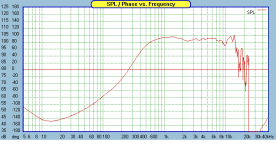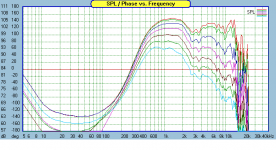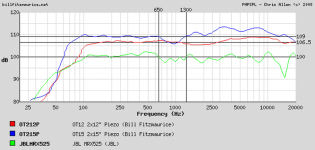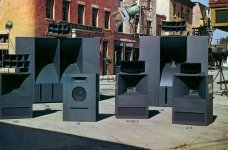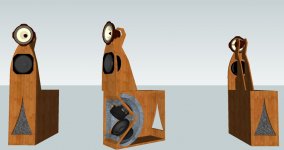As reported in another thread, I compared NSD1095N to DE250.
Each was individually optimised using DEQX.
Results might be different with passive EQ.
Both were on 18sound XT1086 waveguides.
The NSD1095 is "made to match" the waveguide. Flare rate e.t.c.
The DE250 is not.
I don't have impulse response results.
I gave them a long, long, long listening test.
The NSD1095N seemed subjectively more detailed at first listening.
The NSD1095N WAS more detailed after extended listening.
I couldn't find any area in which the DE250 was better.
David
Each was individually optimised using DEQX.
Results might be different with passive EQ.
Both were on 18sound XT1086 waveguides.
The NSD1095 is "made to match" the waveguide. Flare rate e.t.c.
The DE250 is not.
I don't have impulse response results.
I gave them a long, long, long listening test.
The NSD1095N seemed subjectively more detailed at first listening.
The NSD1095N WAS more detailed after extended listening.
I couldn't find any area in which the DE250 was better.
David
Hi David,
Yes, I found it here:
http://www.diyaudio.com/forums/showthread.php?t=135597&page=6
(also lots of valuable comments from Scott, and others.... )
There were lots of debates in that thread, I'm not surprised about that for the subjective stuff, it's usually more so if your opinions happened to point against others. Oops!
Anyway, I do appreciate your efforts, reviews, and sharing about the comparisons of those compression drivers. I think I can understand what you wanted to describe and also tend to agree despite the fact that I've never heard them myself. I'd guess the differences might be similar to other hard and soft diaphragms. Talking about details and dynamics, hard ones usually win.
CLS
Yes, I found it here:
http://www.diyaudio.com/forums/showthread.php?t=135597&page=6
(also lots of valuable comments from Scott, and others.... )
There were lots of debates in that thread, I'm not surprised about that for the subjective stuff, it's usually more so if your opinions happened to point against others. Oops!
Anyway, I do appreciate your efforts, reviews, and sharing about the comparisons of those compression drivers. I think I can understand what you wanted to describe and also tend to agree despite the fact that I've never heard them myself. I'd guess the differences might be similar to other hard and soft diaphragms. Talking about details and dynamics, hard ones usually win.
CLS
Where is Lynn Olson? Is he well? I don't think that he has visited the forum in over a month.
Hi there, yes, I'm still here. I just haven't had any brilliant (or otherwise) ideas to report. I have been corresponding with the local Denver guy who does the Drivervault measurements, but that's been off-line. I'll be at the RMAF with my friends Gary Dahl, John Atwood, and Alexander of RAAL, so if any of you are there, I'll probably be seeing you!
I have been looking carefully at some of the basshorns at the Bill Fitzmaurice site, specifically the OmniTop 12 and 15, which look like good complements to the AH-425 Azurahorn and Altec/GPA 288 compression driver.
Last edited:
Augerpro was kind enough to measure the second GPA 288 on the AH425 horn - and as you can see, it measures differently. (All measurements at 2 meters with no equalization.) This measurement is much closer to Bjorn Kolbrek's measurement of his Altec 288C on his AH425 horn, so the previous measurements of the GPA 288 may indicate a problem with that particular driver.
I'm no horn expert - but I'd guess the phase plug might be misaligned with respect to the diaphragm, producing the broad rise centered around 1.5 kHz and the two sharp nulls at 2.8 and 3.6 kHz. The first driver has a smoother characteristic in the 1~10 kHz region, with the diaphragm breakup region above 10 kHz looking very similar.
I'm no horn expert - but I'd guess the phase plug might be misaligned with respect to the diaphragm, producing the broad rise centered around 1.5 kHz and the two sharp nulls at 2.8 and 3.6 kHz. The first driver has a smoother characteristic in the 1~10 kHz region, with the diaphragm breakup region above 10 kHz looking very similar.
Attachments
Last edited:
Here's the reason I've been poking around the Bill Fitzmaurice site - the OmniTop 15 and 12 look like interesting complements to the AH425. The upper graph is the dual-15 OmniTop 15, and the lower graph is the dual-12 OmniTop 12 (these are fullrange speakers, but the part I'm interested in is the basshorn).
Note the efficiencies of an OmniTop15 and an AH425 with an appropriate large-format compression driver are in the Klipschorn range, with much flatter response. True, the F3 is around 70~80 Hz, but everything below that is direct-radiator subwoofer territory anyway.
The reason you don't see FR response measurements of Klipschorns and Avante-Gardes published is that they aren't very flattering - rough would be the kindest word that applies. By contrast, with a good large-format compression driver (GPA, Altec, and possibly the Radians), the AH425 horn, a 700~900 Hz crossover, and 12+15 or 15+15 BFM OmniTop, a speaker with efficiencies in the 105~109 dB range and reasonably flat response looks eminently possible.
Note the efficiencies of an OmniTop15 and an AH425 with an appropriate large-format compression driver are in the Klipschorn range, with much flatter response. True, the F3 is around 70~80 Hz, but everything below that is direct-radiator subwoofer territory anyway.
The reason you don't see FR response measurements of Klipschorns and Avante-Gardes published is that they aren't very flattering - rough would be the kindest word that applies. By contrast, with a good large-format compression driver (GPA, Altec, and possibly the Radians), the AH425 horn, a 700~900 Hz crossover, and 12+15 or 15+15 BFM OmniTop, a speaker with efficiencies in the 105~109 dB range and reasonably flat response looks eminently possible.
Attachments
Last edited:
A speaker like the combo described above isn't as weird as it seems - historically, it's a descendant of the late-Forties Altec A4 and A5 theater systems, with a basshorn with a vented rear chamber, and a large-format compression driver handling the mids and highs.
The difference is modern modeling techniques - courtesy of BFM, Bjorn Kolbrek, and JMLC - which allows much flatter response than the old-school theater speakers. Not surprisingly, the frequency limits and choice of crossover is similar; 70~80 Hz in the bass, 10 kHz at the top, and a crossover set by the horn size, which was 500 Hz for the big Altec multicells, and 700+ Hz for the AH425.
(1975 Altec catalog photo from the Lansing Heritage site, with minor Photoshop color-correction. The A5 is on the far left, and the A4 is on the far right side of the picture.) I like the sense of scale in this picture; anyone that's seen an A7 in a living room knows they aren't exactly petite, yet they look small here, compared to the mighty A2, intended for 70mm widescreen theaters.
The difference is modern modeling techniques - courtesy of BFM, Bjorn Kolbrek, and JMLC - which allows much flatter response than the old-school theater speakers. Not surprisingly, the frequency limits and choice of crossover is similar; 70~80 Hz in the bass, 10 kHz at the top, and a crossover set by the horn size, which was 500 Hz for the big Altec multicells, and 700+ Hz for the AH425.
(1975 Altec catalog photo from the Lansing Heritage site, with minor Photoshop color-correction. The A5 is on the far left, and the A4 is on the far right side of the picture.) I like the sense of scale in this picture; anyone that's seen an A7 in a living room knows they aren't exactly petite, yet they look small here, compared to the mighty A2, intended for 70mm widescreen theaters.
Attachments
Last edited:
I read that omnitop 12 is a ported horn.
http://forum.speakerplans.com/bill-fitzmaurice-omnitop-12s-built-by-insomnia_topic16096_page6.html
http://forum.speakerplans.com/bill-fitzmaurice-omnitop-12s-built-by-insomnia_topic16096_page6.html
DR280 looks sort of like a Klipsch LaScala. From what I read, it uses one 12" driver.
http://www.billfitzmaurice.com/DR280.html
http://www.billfitzmaurice.com/DR280.html
Last edited:
I see the drift form the original open baffle, colouration-free concept it's quite significant. I mean, instead of a large radiating surface in OB it seems you are more and more interested in horn loaded drivers? Is this a size/spl related compromise?
Do you think a horn loaded driver will perform as well as an open baffle in the 70-700 band?
Do you think a horn loaded driver will perform as well as an open baffle in the 70-700 band?
I'm no horn expert - but I'd guess the phase plug might be misaligned with respect to the diaphragm, producing the broad rise centered around 1.5 kHz and the two sharp nulls at 2.8 and 3.6 kHz.
This kind of problem looks like a resonance of the air around the voice coil. It was quite common for older drivers but with time designers learned to control it.
... By contrast, with a good large-format compression driver (GPA, Altec, and possibly the Radians), the AH425 horn, a 700~900 Hz crossover, and 12+15 or 15+15 BFM OmniTop, a speaker with efficiencies in the 105~109 dB range and reasonably flat response looks eminently possible.
That looks really cool Lynn. I wish they weren't so big, otherwise I'd be building a set! I hope to hear a pair sometime...
This kind of problem looks like a resonance of the air around the voice coil. It was quite common for older drivers but with time designers learned to control it.
Very possible - it's in one driver but not the other, so something isn't right with the manufacturing process. The Tangerine phase plug, unlike traditional circumferential versions, is a plastic assembly glued into the machined throat of the compression driver. My guess, and it is only a guess, is an installation misalignment or a residue of flashing left on the assembly.
The near-identical responses above 10 kHz - which can almost be overlaid on each other - tells me that the diaphragm resonances are very similar. Maybe one of the diaphragms is misaligned; that alone would affect both distortion and the frequency response.
The large-format Radians look interesting, but the factory curves use such a huge amount of smoothing it's difficult to tell what they're really like. As mentioned before, I don't want to design around vintage or unobtainium drivers - a popular design has the noxious effect of driving up ePay prices and rewarding the speculators and hoarders.
Regarding the various bass topologies, here's what I've been thinking ...
I was initially enthralled with the open-baffle concept, but the sad fact is that small-driver (less than 12") systems require heavy equalization (6~20 dB) and are dynamically compromised, and large-driver arrays (2x15, 4x15 or more) are physically huge and create substantial reaction forces on the baffle.
There's a inverse relation between baffle & driver size and the required equalization. At one extreme is a baffle is the size of a wall - the "infinite baffle" beloved of Fifties hifi magazines. At the other extreme are open-baffle speakers the size of conventional low-efficiency audiophile speakers - and these use 10~20 dB of boost equalization.
For folks who are fine with digital equalization - or an array of op-amps - and banks of 200-watt transistor amplifiers, the heavy-EQ route is a reasonable choice. But in terms of power-handling and driver distortion, it is going in the opposite direction of high-efficiency systems. I still think the Gary Pimm approach of heavy-damped near-boxes, or quasi-cardioids, is worth exploring, since it has interesting features, most notably the reduction of the baffle peak and reduced need for equalization.
I briefly considered Onken variations, but the boxes for an Altec-style 414, 416, or AESystems TD15M are the size of medium to large refrigerators and must be extensively braced internally to prevent gross problems with panel vibration. This is inherent in any type of large reflex speaker; the boxes are large, near-square, and have very large open panel areas that demand extensive internal bracing. This results in very heavy enclosures that weigh 100 lbs or more, visually dominate the living room, and require a hand-truck and require at least two strong men to move from one place to another.
If a big speaker is a collection of smaller boxes, it's a little messy looking, but at least it can be transported piece by piece. A single giant box is another matter altogether. I've been to enough trade shows to not enjoy schlepping heavy amplifiers or big speakers from one location to another. Not fun - and I frankly have reservations about the sonics of the really big bass-reflex systems. The drivers are quick, clean, and crisp, but they don't sound that way in boxes of several cubic metres. The walls flap around too much, and clearly audible internal box modes fall into the the upper-bass and lower-midrange regions.
I was contemplating the shorthorn + vented rear chamber of the A5 and A7 when I recalled that Bill Fitzmaurice did an interesting re-work of the Klipsch LaScala some time back. As it turns out, a local friend of mine has LaScala variants, and the principle works: the shallow bass of the stock LaScalas is greatly improved by the additional octave of bass-reflex response, while retaining the traditional basshorn dynamics. Going further, Bill has built horns with smooth curves (the DR series), considerably improving the upper-bass response compared to traditional folded horns.
I wandered over to the BFM website looking for a LF speaker that covered the range from 80 Hz to 800 Hz with reasonably flat response and high efficiency. I found the OmniTop 15.
Bill explains how he designed the OmniTop and Omni series of loudspeakers - it's worth quoting here:
My Omni cabs are straighthorn/reflex cabs, nothing unusual there, though the O10, 12 and 15 vent the port into the horn, and that's very much a seat of the pants design process.
The OmniTop 12 and 15 are more conventional, the ports vent direct. I intially modeled those using HornResp for the horn section, WinISD for the reflex, combining the two, though the final port sizes were determined by testing with completed cabs.
Are there different ways to build bass elements? Obviously, yes. But they all have different sets of tradeoffs. The original reason for open-baffle enthusiasm was elimination, or at least substantial reduction, of panel and box-mode colorations. A big reflex cabinet is the conceptual opposite - large panels with a lot of stored energy, and the bracing only adds weight and complexity. A horn, oddly enough, is partly self-bracing, with smaller panels, so the internal vibration levels in the BFM boxes should be less than a traditional big-box solution.
Last edited:
Gary's cardioid bass chamber has directly influenced what will be the home for the Lowther. Only 46 inches tall and with just enough bass to suit my environs. Should begin in about three weeks and I will actually have someone around who can cut wood closer than my +- 1 foot.
Bud
Bud
Attachments
....
Are there different ways to build bass elements? Obviously, yes. But they all have different sets of tradeoffs.
So true.
However, please don't worry about the boost EQ to the OB bass, it's just some more gain in line level signals. 2 or 4 15" pro sound woofers per side are more than enough in domestic use. (I'm using 4 18" total in 3-channel configuration. More than I need.) They actually move very little, even in loud bass passages. So there's not much stress on the drivers. The real power requirement is also much less than expected. And the baffle vibrating problem can be overcome, too. So there's not much wrong with OB bass, actually. The clean, coherent, coloration-free performance of OB bass is very admirable, especially with the help of T-bass circuit.
Have tried big and small baffles, I actually like the smaller one I'm using now. It's very interesting that the EQ boosts for those different size baffles are not much different in my space.
On the other hand, true horn bass (all the way down) is oh so excellent and mind-blowing. No doubt it's so addictive. How I LOVE horn bass! But, they are SO HUGE! And can not be fitted in my room. A real bass horn needs long path length thus proper delay for the mid-high section is essential. This inevitably brings up the digital things.
Horn and OB bass are my top two choices, now I'm using the latter just because the size issue. A proper OB is much smaller than a proper horn. So why worry about the size of OB?
So true.
Horn and OB bass are my top two choices, now I'm using the latter just because the size issue. A proper OB is much smaller than a proper horn. So why worry about the size of OB?
A real bass horn is very good, a real OB bass system is better (in our small listening rooms.)
When using a phony horn like Olson speaks of here or using too little surface area in the OB's like only a couple of 15's a side I say why bother in spending so much time and effort with such a poor mediocre performance compromise?
A real bass horn is very good, a real OB bass system is better (in our small listening rooms.)
When using a phony horn like Olson speaks of here or using too little surface area in the OB's like only a couple of 15's a side I say why bother in spending so much time and effort with such a poor mediocre performance compromise?
How many 15s per side are you suggesting is sufficient?
- Home
- Loudspeakers
- Multi-Way
- Beyond the Ariel
